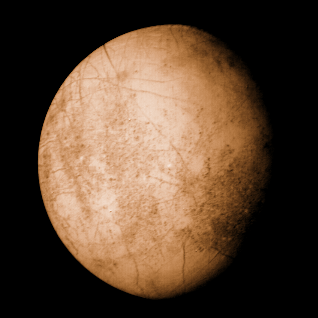Monday March 2 11:19 AM EST
Ocean of slush seen on Europa
UPI Science News

PROVIDENCE, R.I., March 2 (UPI) _ New pictures of the surface of Europa, one of the moons of Jupiter, show evidence of an ocean of slush just below its icy
crust, suggesting that it has all the basic building blocks for life. The researchers say the new images taken by the Galileo spacecraft in December, 1997, portray a
chaotic landscape littered with structures that look like icebergs and gaps between the large continent- sized ice plates.
New Photos Back Theory Of Slushy Jovian Moon
By Kathy Sawyer
Washington Post Staff Writer
Tuesday, March 3, 1998; Page A07

The most detailed images ever taken of Jupiter's moon Europa provide
fresh evidence that the frozen surface of this ice world hides a warmer
ocean of slush, or water, that could harbor life, scientists reported
yesterday.

NASA's spacecraft Galileo last year produced dramatic pictures of
300-foot-high icebergs that had drifted and turned in unseen currents, as
well as other evidence confirming what scientists had long suspected: that a
vast ocean once flowed beneath Europa's hard, bright surface. The
lingering question was whether that hidden sea had since frozen solid.
The latest close-up images -- up to 20 times more detailed than the last --
are enough to convince at least some scientists it has not, though others still
have questions that might be answered only by planned future missions to
Europa.

"I'm confident there's liquid water at depths below the surface," said
Galileo imaging team scientist James W. Head III, a planetary geologist at
Brown University in Providence, R.I., where the latest images were
released. "The question is how deep."
The images -- taken by Galileo in mid-December -- contain three key lines
of evidence from three different geological environments at three different
spots on the moon's surface. Taken together, he said, they support the
hypothesis that Europa is slushy just beneath its thin icy crust, and possibly
even warmer at greater depths.

The moon's combination of "interior heat, liquid water, and infall of organic
material from comets and meteorites means that Europa has the key
ingredients for life," Head said. "Europa, like Mars and the Saturn moon
Titan, is a laboratory for the study of conditions that might have led to the
formation of life in the solar system."
Europa is slightly smaller than Earth's moon, but many times brighter, with
a surface temperature of minus 260 degrees Fahrenheit -- frigid enough to
hard-freeze a primordial ocean over several million years. But scientists
have proposed that Europa's gravitational tug of war with Jupiter and
neighboring moons -- causing tidal bulging -- generates enough heat to
keep large parts of its subsurface ocean thawed.

The ice world has intrigued scientists since the twin Voyager spacecraft
conducted the first close reconnaissance of the Jupiter system in 1979. The
latest images, which show truck-sized objects on the surface, are hundreds
of times more detailed than the best Voyager images and between three
and 20 times more detailed than Galileo's earlier Europa pictures.
The key pieces of new evidence, as presented by the Galileo researchers,
are:

A relatively recent impact crater where a meteorite slammed into Europa
and threw up dark debris from deep down. The images indicate that the
crater's basin is nevertheless shallow, suggesting that the subsurface ice
was warm and mushy enough to collapse and fill in the deep hole.
The first close-ups revealing the rough texture and "swirly" patterns in the
material in which the previously photographed chunks of iceberg appear to
have floated. The texture suggests a watery slush that rose up from below
and froze instantly.

Gaps between plates of ice appear to have spread. They also appear to
have been partly filled in with wedged-shaped pieces of darker, newer
material -- slushy ice or liquid water -- that welled up, froze and cracked.
The researchers compared the resulting pattern of narrow linear ridges and
parallel grooves in these wedges to new crust formed at mid-ocean ridges
on the Earth's sea floor.
The researchers concluded that these activities are recent and ongoing
because the surfaces involved show so little cratering from meteorite
impacts, compared to an ancient surface. However, according to Michael
Carr of the U.S. Geological Survey, the Galileo mission itself has provoked
a blossoming dispute about whether the underlying models of impact
frequency in the outer solar system are correct. This, he said, has
introduced a small but frustrating note of ambiguity into the story told by
these "fantastic pictures."

Galileo will make further studies of Europa in coming months, and NASA's
Europa Orbiter Mission, to be launched in 2003, will seek to determine the
nature and size of any subsurface seas there, said Galileo scientist Michael
J. S. Belton, of the National Optical Astronomy Observatory in Tucson.

© Copyright 1998 The Washington Post Company
Back To Cavern 5309 Entrance










